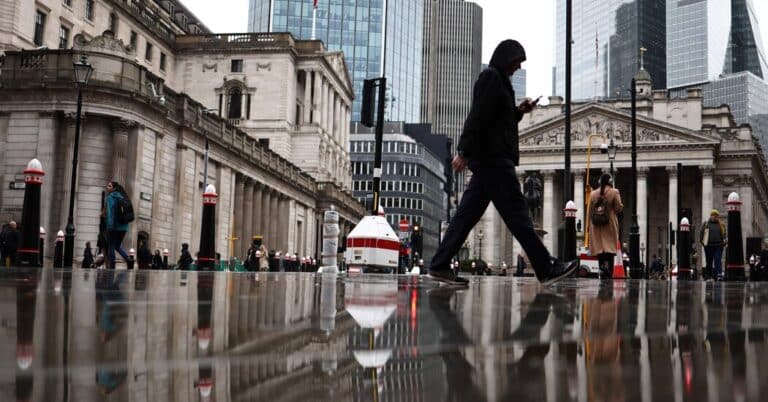The Bank of England held interest rates at the highest levels in 15 years on Thursday, though policymakers were again divided on the best course of action to stamp out high inflation.
Six members of the central bank’s nine-member rate-setting committee voted to keep rates at 5.25 percent amid signs that inflation would continue to ease and the economy was weakening. But they said restrictive monetary policy would be needed for an “extended” period, a stronger stance than before, according to the minutes of this week’s policy meeting.
“Higher interest rates are working and inflation is falling,” Andrew Bailey, the governor of the bank, said in a statement. But the bank needed to see inflation falling “all the way” to its 2 percent target, he added, and so policymakers would be “watching closely to see if further rate increases are needed.”
While Britain braces for this long period of high rates, the economic outlook has darkened. The economy would flatline for most of the next two years, the bank said in projections that accompanied the rate decision. The forecasts also highlighted the challenge policymakers face eradicating high inflation, which stuck at 6.7 percent in September. In 2024 and 2025, the inflation rate is expected to be slightly higher than was forecast a few months ago. For example, inflation would slow to 3.4 percent at the end of next year, compared with a previous forecast of 2.8 percent.
Three other committee members voted to raise rates another quarter-point to ward against the risks of “more deeply embedded inflation persistence,” the meeting minutes said. Even though the economy was weakening, household incomes were growing because of lower inflation and indicators of economic output remained positive, they said.
This was the second consecutive meeting that rates were held steady, ending a nearly two-year run of rate increases to tackle stubbornly high inflation. At the previous meeting in late September, a slim majority of five-to-four voted to hold rates.
The decision on Thursday mirrors ones made by the Federal Reserve on Wednesday and the European Central Bank last week to leave interest rates unchanged because there was evidence that tight monetary policy was cooling their economies and easing inflation pressures. All these central banks left open the possibility of further rate increases, but have shifted their focus to how long rates will stay at these levels to ensure inflation returns to their 2 percent targets.
In Britain, the inflation rate has dropped to just below 7 percent, from a peak of about 11 percent a year ago. In September, inflation defied economists’ expectations of a further decline as an increase in fuel prices offset the slowdown in food price growth.
Policymakers at the Bank of England said that there were risks that inflation could be pushed higher by energy prices because of the conflict in the Middle East. But so far, there had only been a “relatively limited” increase in energy prices, the bank said.
Other measures of inflationary pressures that policymakers watch closely have shown early signs of easing. Inflation in the services sector was slightly weaker than expected, while the labor market is loosening with higher unemployment and fewer job vacancies.
But complicating the picture for policymakers has been a change in the labor market data provided by the Office for National Statistics. Because of a decline in the number of households participating in surveys used to estimate the unemployment rate and other indicators, the statistics agency’s latest jobs report relied on “experimental” data based on tax and state benefits information. These new measures “need to be interpreted with caution,” the bank said, adding that it was using a “wide range of data” to make its judgments.
Inflation is forecast to drop to 4.9 percent in October because a decline in the price cap for household energy bills is expected to offset increases in other fuel costs, the bank said. And then the rate is projected to fall further, to about 4.6 percent by the end of the year. That would allow Rishi Sunak, the prime minister, to meet this pledge of halving inflation this year.
After that it will take longer for inflation to return to the bank’s target. If interest rates do not change again, inflation will not reach 2 percent until the end of 2025.
“It’s much too early to be thinking about rate cuts,” said Mr. Bailey, who voted to hold rates steady.
The impact of high interest rates is set to take an increasingly heavy economic toll. Rates have been raised from near zero in late 2021, an aggressive pace of tightening, but less than half of the impact has yet been felt in the economy, the bank estimated. So far, the most adverse impact has been in the housing market, where investment has slowed. It will take longer for business investment and household consumption to weaken too.
The full effect on economic output from higher rates will not be felt until 2025, the bank said.


